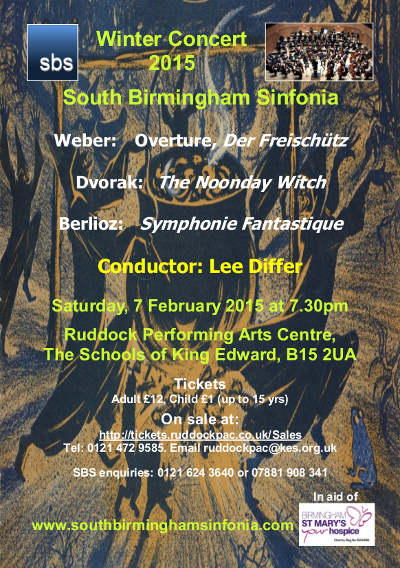7th February 2015, at the Ruddock Performing Arts Centre.
The theme for winter 2015 was the magical. Weber transformed opera in the 19th century with a series of works of which Der Freischütz (The ‘free shooter’ or ‘marksman’) is possibly the best. The plot is thick with sorcery, the casting of magic bullets, etc., and the overture is just as magical as the rest of it. Dvořák’s excellent tone poem ‘Polednice’ is not so often heard, which is a pity. It draws on Czech folk tales of witches and magic and should be a treat for the audience. The concert is rounded off with Berlioz’s images of witches in the well-known Symphonie Fantastique.
- Weber’s Overture to Der Freischütz
- Dvořák’s Tone poem Polednice (The Noonday Witch)
- Berlioz’s Symphonie Fantastique
Weber’s Overture to ‘Der Freischütz’
Weber’s opera ‘Der Freischütz’ (the ‘free shooter’ or ‘marksman’), first performed in 1821, is based on a German folk tale and is full of sorcery, magic. The famous “Wolf’s Glen Scene” portrays the casting of the magic silver bullets central to the story. Der Freischütz is often regarded as the first great romantic Germanic opera and was a huge influence on Wagner, and also Berlioz, who created a French version for production in Paris.
Dvořák’s Tone poem ‘Polednice’ (The Noonday Witch)
Poldenice is the Czech name for the slavic sorceress (usually translated into English as the noon witch or the noonday witch, but “mid-day witch” might be better) pictured as a young woman in white carrying a scythe or shears and roaming the fields at the height of the day in summer, striking workers down with heat stroke and madness. She often takes the form of whirling dust clouds and often stops to engage people in conversation to ask them riddles or difficult questions. Woe betide those who cannot answer correctly!
In Dvořák’s tone poem, a mother warns her son that if he does not behave she will summon the Witch to take him away. He does not, and the witch arrives at the stroke of noon. The witch demands the child. The mother, terrified, grabs her son, and the witch chases them. Finally the mother faints, grasping her child. Later that day, the father arrives home, and finds his wife passed out with the dead body of their son in her arms. The mother had accidentally smothered him, while protecting him from the witch. The story ends with the family’s lament over the terrible event.
Dvořák’s music follows the story closely. The final version we shall hear was first performed in London in 1896 under Henry Wood.
Berlioz’s Symphonie Fantastique
Berlioz’s Symphonie Fantastique, (“Fantastic Symphony: An Episode in the Life of an Artist, in Five Parts”) is a five movement work based on a programme inspired by De Quincy’s “Confessions of an Opium Eater” and by Berlioz’s own love for the Irish actress Harriet Smithson. It was first performed in 1830.
The five movements are as follows.
- Rêveries – Passions (Daydreams – Passions). A young musician, sees for the first time a woman who unites all the charms of the ideal person his imagination was dreaming of, and falls desperately in love with her.
- Un bal (A ball). In the tumult of a festive party, in the peaceful contemplation of the beautiful sights of nature, whether in town or in the countryside, the beloved image keeps haunting him and throws his spirit into confusion.
- Scène aux champs (Scene in the Country). Hearing a pastoral duet given by two shepherds in the distance gives some cause for hope that he has recently conceived, all conspire to restore to his heart an unaccustomed feeling of calm and to give to his thoughts a happier colouring. He broods on his loneliness, and hopes that soon he will no longer be on his own.
- Marche au supplice (March to the Scaffold). Convinced that his love is unappreciated, the artist poisons himself with opium. The dose of narcotic, while too weak to cause his death, plunges him into a heavy sleep accompanied by the strangest of visions. He dreams that he has killed his beloved, that he is condemned, led to the scaffold and is witnessing his own execution.
- Songe d’une nuit de sabbat (Dream of a Witches’ Sabbath). He sees himself at a witches’ sabbath, in the midst of a hideous gathering of shades, sorcerers and monsters of every kind who have come together for his funeral. Strange sounds, groans, outbursts of laughter; distant shouts which seem to be answered by more shouts. The beloved melody appears once more, but has now lost its noble and shy character; it is now no more than a vulgar dance tune, trivial and grotesque: it is she who is coming to the sabbath.
Unlike in Berlioz’s fantasy, Harriet Smithson heard the music and obviously appreciated it. Berlioz and Smithson married in 1833 but the marriage was not to be a happy one and they eventually separated.

